In our last few blog posts, we’ve talked about customer segmentation and different ways to segment your target audience into smaller chunks like demographic and psychographic segmentation to connect with the right people. Customer segmentation enables marketers to focus their marketing efforts on their target customers, improving their marketing targeting strategy.
But what if there was a subset of users that had an even bigger impact when targeted? Enter Super Users – the strategic players who can give your ROI numbers a major boost! It may take some trial-and-error testing to pinpoint these super segments accurately, but knowing how these key individuals interact is essential for any successful marketing targeting strategy.
What is a Super User?
As technology progresses and media consumption grows, a unique group is rising to the top.
Activate Consulting’s Technology & Media Outlook 2023 found that Super Users are powering the digital world, with a strong presence across all major media and technology verticals. This select crowd is made up of young, educated individuals who lead affluent lifestyles – spending more time and money than any other user group!
Why should you add Super Users to your marketing targeting strategy?
Super Users are a highly influential audience with the potential to drive major business growth. They stand out from other users in their commitment and dedication across four key areas:
- Time spent with media
- Spend
- Technology and media adoption
- Emerging eCommerce behaviors
“Over the next years, the imperative for technology and media companies will be to identify, reach, and super-serve Super Users – the single group of power users whose time and spend far surpass those of other users.”
Activate consulting’s technology & media outlook 2023
You can use Super Users as a subset of your marketing targeting strategy. While you may need to reach beyond Super Users to achieve your goals, it’s worthwhile to consider:
- Targeting them separately
- Spending more on media
- Reaching them at a higher frequency
Time spent with media
Super Users make a powerful impact, despite comprising only 22% of the U.S. population. They are incredibly influential in terms of media consumption and engagement – spending more than double the amount of time interacting with content compared to other users.
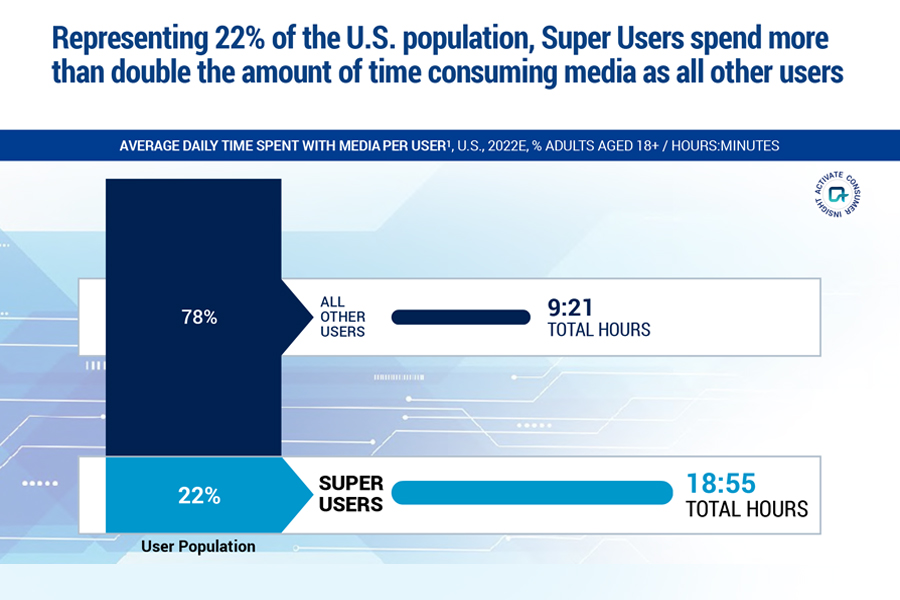
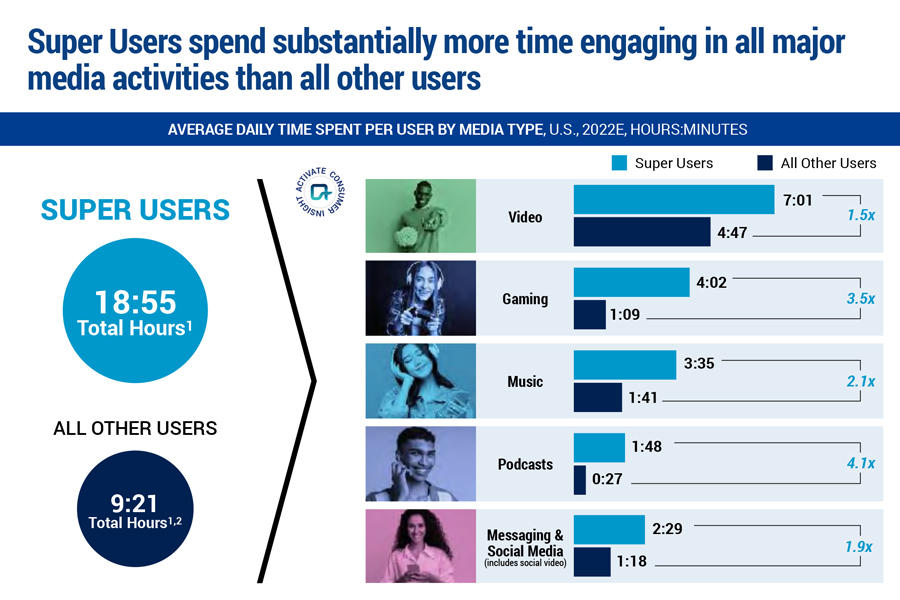
Inclined to multitask
Super Users take multitasking to the next level. Not only do they spend more time with electronics, but they excel in the art of juggling multiple activities. While watching videos and playing video games on one device, Super Users might also be busy engaging with social media on another. This makes them an unstoppable force when it comes to getting the most out of their digital experiences!

High share of dollar spend
Super Users are big spenders when it comes to media, particularly in gaming and music. Compared with all other users, Super Users’ average video spend is close to triple the amount ($76 vs $27). However, their biggest increases come from gaming and music; they’re collectively spending 12x more on games and shelling out 21x as much for tunes!
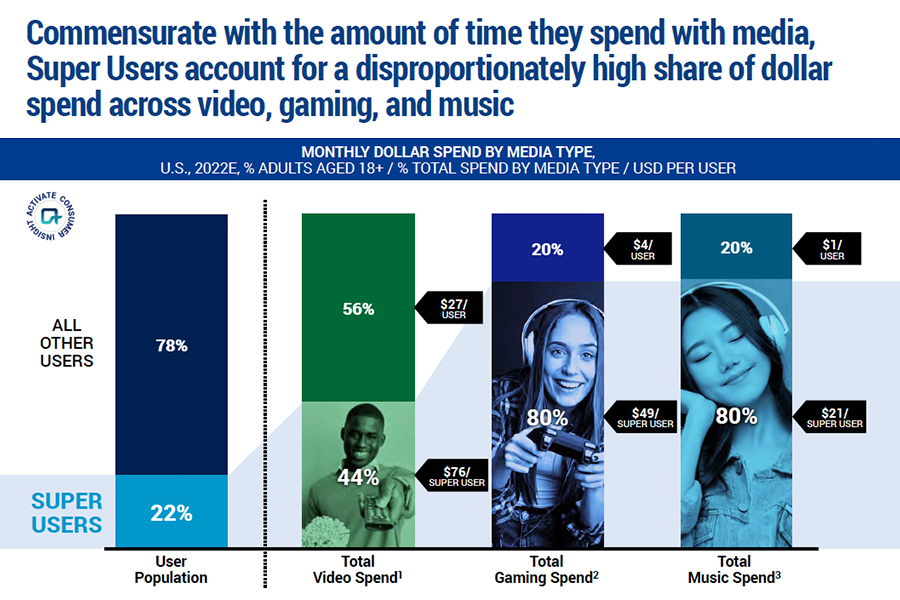
With 60% of eCommerce spend coming from Super Users, they are driving the industry forward with their enthusiasm and willingness to test out cutting-edge shopping trends like buying through social media, live streaming purchases, and trying on products virtually. Super Users are setting the tone for this dynamic industry.
Technology and media adoption
Most Super Users are brand advocates. They’re trendsetting individuals who stay ahead of the curve on media and technology. They eagerly take advantage of new products, services, and data-sharing opportunities to receive tailored ads that fit their lifestyle.
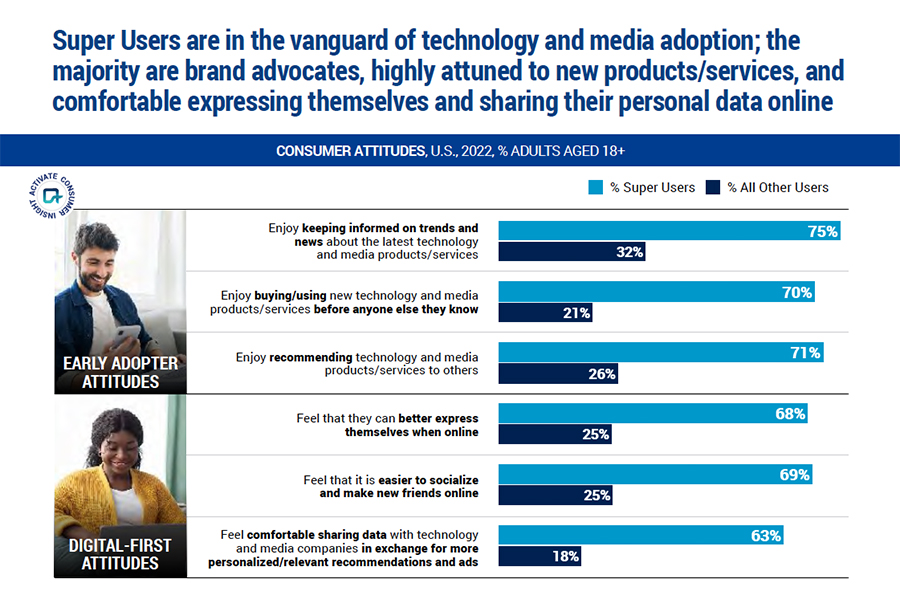
Crypto & NFTs
Super Users blaze the trail for cryptocurrency and non-fungible tokens (NFTs)! This group is five times more likely to explore, engage with, and embrace new digital-monetary technologies.
Pioneers of the Metaverse
As Metaverse usage continues to rise, Super Users are leading the way. Over 80% of these trailblazers have embraced these digital spaces within just the last year. We’re seeing accelerated interest from them as they seek out new opportunities for creativity, connections, and transactions within their favorite Metaverses. Many express interest in Metaverse experiences such as purchasing physical items to creating virtual havens. In fact, they’re 5x more interested in all things meta-related!
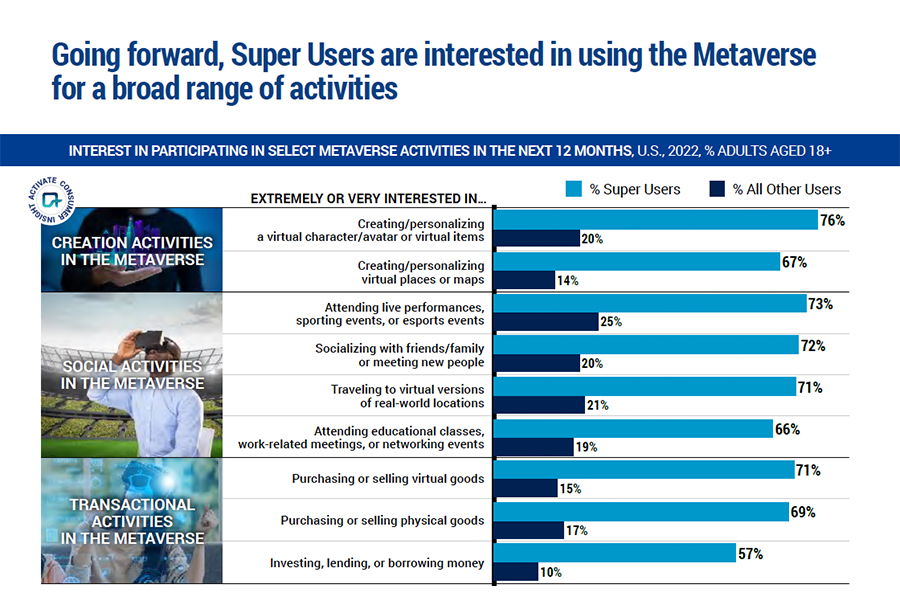
How Experian can help you identify and target Super Users
So how can you find your Super Users and include them in your marketing targeting strategy? Whether you want to build or acquire highly addressable audiences, we can help you precisely reach the right individuals and households in any channel you desire with Consumer View.
Consumer View
It all starts with data. Delivering the right message in the right place at the right time means truly knowing your prospects and customers as individuals – their lifestyles, behaviors, and shopping preferences. Consumer View data can provide a deeper understanding of your customers.
Consumer View is the world’s largest consumer database that contains over 3,900 attributes for 250 million adult consumers in the U.S. with coverage of 126 million (98%) of U.S. households. Consumer View can help you find out:
- What do your customers look like?
- What do your customers do?
- How and when should you reach your customers?
- What motivates your customers?
Modeled and syndicated audiences
We have over 2,500 pre-built audiences that are privacy-safe and built using advanced data science and the most comprehensive consumer data available. These digital audiences are readily available via major publishers, data management platforms (DMPs), advanced TV operators, and demand-side platforms (DSPs).
Our pre-built audiences can be used consistently across multiple distribution partners – making sure you can quickly find the right audience for the right campaign without having to build your own consumer personas. In addition to being available as digital audiences, our segmentation products are also available to use across all consumer touchpoints to enable consistent omnichannel campaign targeting.
There are infinite data combinations and selections we can help you with for optimal audience targeting. Using our comprehensive inventory of data, we can find even the most unusual of audiences to help you connect with new prospects. From demographics to behavioral and psychographic information, we draw on a massive base of knowledge accumulated during five decades in business.
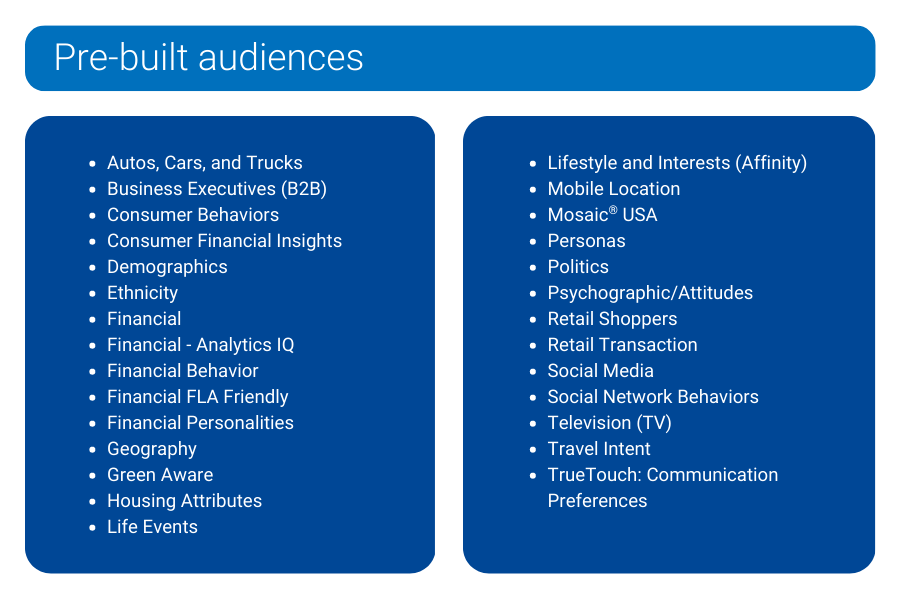
Mosaic® USA
Experian’s Mosaic® USA is a household-based consumer lifestyle segmentation system that classifies all U.S. households and neighborhoods into 71 unique types and 19 overarching groups, providing a 360-degree view of consumers’ choices, preferences, and habits. Using Mosaic lifestyle segmentation, you can anticipate the behavior, attitudes, and preferences of your best customers and reach them in the most effective traditional and digital channels with the right message in the right place at the right time.
Tailored Segmentation uses a sophisticated data-driven clustering system that leverages the 71 Mosaic types that match to first-party data like yours. Tailored Segmentation allows you to regroup Mosaic types based on the attributes you weigh as more impactful to your business. Have you designed your own segments in-house? You can apply Tailored Segmentation to those segments for deeper insights through a tailored analysis. Are you still looking for a way to segment your market even though you understand your typical best customer? Tailored Segmentation can weigh these attributes and develop a custom clustering and analysis of your market.
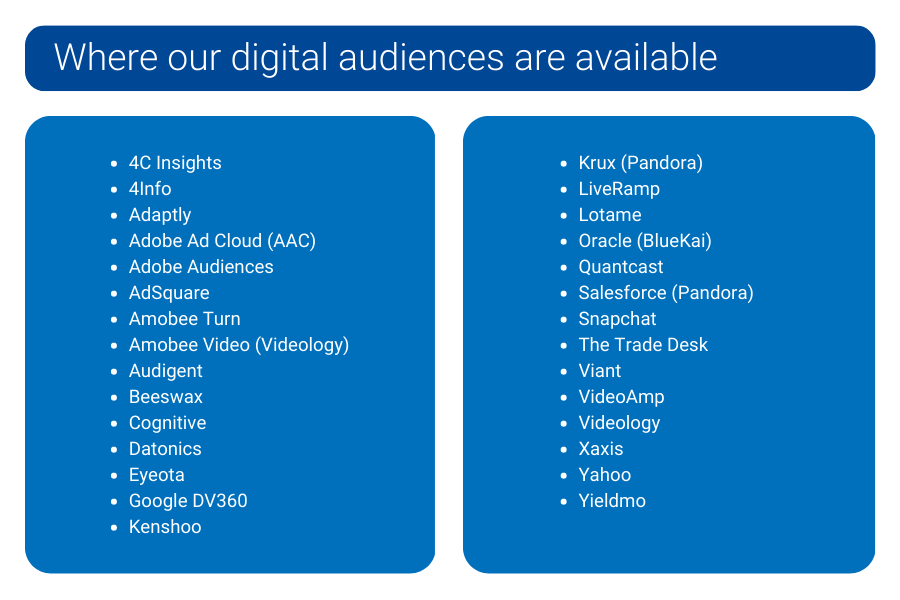
We can help you find your Super Users
Super Users are an important segment of any market. Marketers need to be able to identify them quickly and act upon their insights. Our marketing solutions provide the necessary data and analytical capabilities to easily find and target your potential Super Users for an effective marketing targeting strategy.
With Experian, you can deliver messages that are more in line with what matters to this influential group of customers. We understand how challenging it can be to find these customers and ensure they get the tailored, personalized messaging they deserve – so let us help you do just that! We can provide deep insights beyond the generic customer persona that allows marketers to look into the effectiveness of their marketing strategies from multiple angles. We want to help you gain an edge over your competitors by helping you identify, target, and engage Super Users for increased revenue growth. Ready to find your Super Users?
Sources
Activate Technology & Media Outlook 2023. Activate Consulting.
Latest posts

As marketers, we all want to better leverage data to understand our customer and provide them with the best possible experience. It not only better serves our clients, but is ultimately more profitable for the company. But most of us struggle with large volumes of data, with no idea how to best use it. There are many factors that play into this problem. For most organizations, data is spread out across multiple systems with no consistent data management strategy. That means that as marketers, when we get the data, it comes in a wide variety of forms. The standardization could be different, customers could be missing certain record fields, purchase history could be divided into different accounts…you get the picture. This disparity makes it difficult for us to get any sort of insight from the information. How can we leverage data if it is inaccurate, incomplete and not accessible? Experian Data Quality recently completed a survey of over 250 chief information officers (CIOs) and found that they too are struggling to leverage data. Four out of five see data as a valuable asset that is not being fully utilized within the organization. In speaking with the CIOs, some of the biggest challenges aren’t just about technology, but rather organizational structure and company culture. Sixty-eight percent of CIOs struggle to find stakeholders who take anything other than a siloed view of data management. In addition, 70 percent of respondents say they struggle to implement data-driven decision making because no one seems to own the process. To improve data insight, organizations need to improve the structure around data management. This is where the chief data officer (CDO) comes into play. The chief data officer is a growing c-suite position that is getting more and more popular. Most of the CIOs we spoke with that had a CDO said the role had only been created in the last six months. The reasons companies are looking to put a CDO in place are all related to improving access and insight from data. CDOs are there to: Reduce risk around data-driven projects Curb costs from poor quality data Handle increasing data governance pressures As this role continues to grow, it is going to have a big impact not only on marketing, but also the organization as a whole. With that in mind, join us for a webinar on Tuesday, August 18th at 2 PM EST to talk about the emergence of the chief data officer. We’ll discuss data as an untapped resource, how the role is changing organizations and how to ensure your organization is ready for the shift that this new role brings. Register today!

There is much to be said about the differences between college-age consumers (19- to 21-year-olds) today and their counterparts five years ago. As many marketers recognize, young-adult consumers cannot be targeted based solely on generalizations and assumptions. To accurately and respectfully capitalize on this segment’s buying power, marketers need to understand how their spending patterns have changed in recent years and how to earn a slice of the group’s spend. Accounting for inflation, 19- to 21-year-olds are making more money than young adults did five years ago. Their pay has increased by 20 percent, and, interestingly, their spending has increased by 30 percent. So where are they spending this money? 1. Dressing for success According to Census Area Projected Estimates (CAPE) of expenditure data from Experian Marketing Services, both men and women in this age group are filling their closets with about 35 percent more professional attire — shoes included. This has brought 2015’s average spend up to $22,859 per year per household for college-age women and $11,196 per household for college-age men. This rise in spending on professional wardrobe could be attributed to more professional entry-level job expectations or a possible shift in technical trade positions to business professional positions. CAPE data also reveals a 70 percent increase in memberships to networking and recreational clubs. This increasingly professional outlook among college age consumers requires confidence and the right ensemble to proclaim success. Key takeaway: Position products and services to appeal to this career-minded consumer who is aiming to look the part. 2. “Go with the flow” What kinds of messages resonate with these individuals? According to TrueTouchSM data from Experian, college-age consumers can be best engaged when marketers appeal to them using a “Go with the flow” marketing message. “Go with the flow” has consistently ranked as the top motivating marketing message for college-age individuals in the study. The second and third most resonating marketing messages for this market are “Never show up empty handed” and “Work hard, play hard.” “Go with the flow” means this market has a live-and-let-live outlook on life. Brands who employ a similar outlook, don’t take themselves too seriously and extend no-risk offers may have a better chance to engage this cohort. Key takeaway: If marketers tailor messages around these motivating philosophies, they may have a better chance of earning this market’s business. 3. Offline entertainment For marketers in the retail industry, particularly those with clothing or supplies fit for the outdoors, be aware that this cohort of 19-21 year olds are visiting outdoor apparel and supplies sections more often than they did five years ago. In fact, they are spending 37 percent more on luggage and travel than the same age group 5 years ago. According to the same Experian CAPE study, renting RV’s and increasing spend on camping and winter sports equipment are expenditures getting more attention from college-age consumers this year. Key takeaway: Despite being pegged as a technology-first generation, this cohort also enjoys going “off the grid.” Even if you aren’t selling outdoorsy equipment, be aware that there is more to this age group than smartphones and Netflix. Combine the “go with the flow” attitude with their sense of adventure to better cater your messages to these consumers. A lot has changed in five years. Marketers trying to engage college-age consumers need to understand how spending habits (and motivations) are changing in order to provide the most relevant brand experiences and capture this hard-to-pin-down market. To see how Experian Marketing Services’ rich consumer data can help you profile your best customers, visit our website.

Data may not be the most glamorous aspect of marketing but it is at the heart creating meaningful consumer interactions in today’s data-driven world. In our award-winning, annual Digital Marketer Report we asked senior leaders about their top challenges and priorities. They said things like standing out against competitors, creating relevant interactions and customer acquisition. To my surprise, they didn’t say data. However, all the top challenges and priorities are predicated on having accurate, enriched data that is linked together in a central location for a complete customer view. The sobering fact is that most brands are not there yet. Most are not fully utilizing their data assets and maximizing their marketing intelligence. Take a look at these stats from the Digital Marketer Report to get an idea of where most brands are with data management practices. Overall, 45% of companies collect data via mobile – be it a mobile website, app or both TWEET THIS! 97% of companies suffer from common data errors. 61% of companies named human error as a top reason for data inaccuracies. TWEET THIS! On average globally, companies believe that 23% of their budget is wasted annually due to poor data quality. TWEET THIS! Today, only 35% of companies manage their data centrally through a single director. TWEET THIS! 99% of companies believe achieving a single customer view is important to their business. Only 24% of companies say they have a single customer view today. TWEET THIS! 29% of marketers who enrich their data with third-party data only add one type of data. TWEET THIS! One-quarter of marketers don’t enrich their data with any kind of third-party data. TWEET THIS! It’s important for marketing leaders to understand that they first need to focus on data and creating a customer-centric organization to support good data-management practices. Only then will they be able to reach their goals.